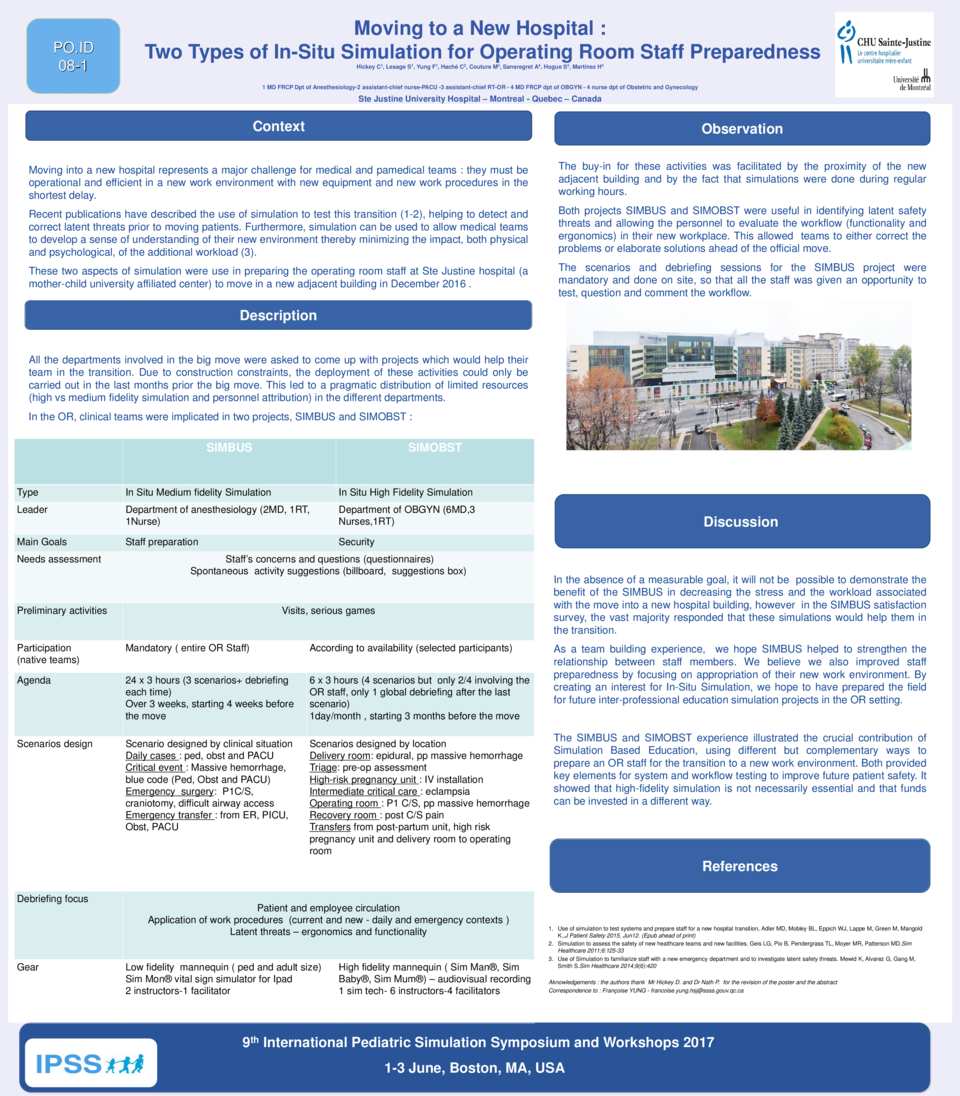Abstract
Context
Moving into a new hospital represents a major challenge for medical teams : a new work environment with new equipment and new work procedures.Recent publications have described the use of simulation to test this transition, helping to detect and correct latent threats prior to moving patients (1). Furthermore, simulation can be used to allow medical teams to develop a sense of understanding of their new environment thereby minimizing the impact, both physical and psychological, of the additional workload(2).These two aspects of simulation were used in preparing our OR staff (a mother-child university affiliated center) to move into a new adjacent building in 2016.
Description
All the departments involved were asked to come up with projects which would help their teams in the transition. Because of construction constraints, the deployment of these activities could only be carried out in the last months prior the big move. This led to a pragmatic distribution of limited resources (high vs medium fidelity and personnel attribution) in the different departments.. The OR staff were implicated in two projetcs
SIMBUS (in-situ medium fidelity simulation )
- main goal : staff preparedness
- mandatory participation
- preliminary activities : visits, serious games
- senario designed by clinical situation : daily cases and critical events, emergency surgery and transfer
- agenda : 24 x 3 h ( 3 scenarios + debriefing) over 3 weeks, starting 4 weeks prior the move
SIMOBST (in-situ high fidelity simulation)
- main goal : security
- selected participants
- preliminary activities : visits, serious games
- scenarios designed by location : delivery room, triage, operating room etc.
- agenda : 6x3 h (2/4 scenarios + 1 debriefing) 1 day/month starting 3 months prior the move
Debriefing focus (SIMBUS & SIMOBST)
- patients and employee circulation
- latent security threats
- work procedures
Observation
The buy in for these activities was facilitated by the proximity of the new building (adjacent to the old one) and by the fact that simulations were done during regular working hours.
Both projects were useful in identifying latent safety threats and allowing the personnel to evaluate the workflow (functionality and ergonomics) in their new workplace. This allowed the teams to either correct the problems or find new ways of solving them before the move.
The scenarios and debriefings for the SIMBUS project were mandatory and done on site, so that all the staff was given an opportunity to test, question and comment the workflow.
In the SIMBUS satisfaction survey, the majority responded that these simulations would help them in the transition.
Discussion.
As a team building experience, we hope SIMBUS helped to strengthen the relationship between staff members and improved staff preparedness by focusing on appropriation of their new work environment. By creating an interest for In-Situ Simulation, we hope to have prepared the field for future inter-professional education simulation projects in the OR setting.
SIMBUS-SIMOBST experience showed different but complementary ways to prepare an OR staff for the transition to a new work environment. Both provided key elements for system and workflow testing to improve future patient safety. It showed that high-fidelity simulation is not necessarily essential and that funds can be invested in a different way.
References
2.Sim Healthcare 2011;6:125-33
3.Sim Healthcare 2014;9(6):420






